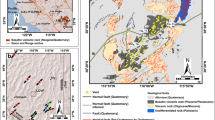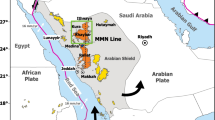Abstract
Distributed “monogenetic” volcanic eruptions commonly occur in continental settings without obvious structural alignments or rifting/extensional structures. Nevertheless, these may develop as fissures, representing the surface expression of dykes with a range of orientations, especially when stress regimes vary over time and/or older crustal features and faults are exploited by rising magmas. Dykes reaching the surface as fissures can last hours to months and produce groups of closely aligned vents, hiding the true extent of the source fissure. Grouped or aligned vents in a distributed volcanic environment add complexity to hazard modelling where the majority of eruptions are single-vent, point-source features, represented by cones, craters or domes; i.e. vent groups may represent fissure events, or single eruptions coincidently located but erupted hundreds to tens of thousands of years apart. It is common practice in hazard estimation for intraplate monogenetic volcanism to assume that a single eruption cone or crater represents an individual eruptive event, but this could lead to a significant overestimate of temporal recurrence rates if multiple-site and fissure eruptions were common. For accurate recurrence rate estimates and hazard-event scenarios, a fissure eruption, with its multiple cones, must be considered as a single multi-dimensional eruptive event alongside the single-vent eruptions. We present a statistical method to objectively determine eruptive events from visible vents, and illustrate this using the 968 vents of the 10 Ma to 0.6 ka volcanic field of Harrat Rahat, Saudi Arabia. A further method is presented to estimate the number of hidden vents in a thick volcanic pile. By combining these two methods for Harrat Rahat, we determined an updated spatial recurrence rate estimate, and an average temporal recurrence rate of 7.5 × 10−5 events/year. This new analysis highlights more concentrated regions of higher temporal hazard in parts of Harrat Rahat, which has significant implications for the city of Al-Madinah and surroundings.







Similar content being viewed by others
References
Al-Samhoody NAA (1440–1506) Wafa Al-Wafa Bi-Akhbar DarAl-Mustafa. Reprinted (1955) by Mohammad Mohiuddin Abdul Hamid with comments. Dar Al-Ahya Al-Sarawat Al-Gharbi, Beirut, Lebanon
Aspinall WP (2010) A route to more tractable expert advice. Nature 463:294–295
Aspinall WP, Cooke RM (1998) Expert judgement and the Montserrat Volcano eruption. In: Mosleh A, Bari EA (eds) Proceedings of the 4th International Conference on Probabilistic Safety Assessment and Management PSAM4, 13–18 September 1998, New York City, USA. Springer, New York, pp 2113–2118
Aspinall WP, Woo G (1994) An impartial decision-making procedure using expert judgement to assess volcanic hazards. Atti dei Convegni Lincei 112:211–220
Bebbington MS (2013) Assessing spatio-temporal eruption forecast in a monogenetic volcanic field. J Volcanol Geotherm Res 252:14–28
Bebbington MS, Cronin SJ (2011) Spatio-temporal hazard estimation in the Auckland Volcanic Field, New Zealand, with a new event-order model. Bull Volcanol 73:55–72
Becerril L, Cappello A, Galindo I, Neri M, Del Negro C (2013) Spatial probability distribution of future volcanic eruptions at El Hierro Island (Canary Islands, Spain). J Volcanol Geotherm Res 257:21–30
Blank HR, Sadek HS (1983) Spectral analysis of the 1976 aeromagnetic survey of Harrat Rahat, Kingdom of Saudi Arabia. USGS-OF-03-67, 29 pp
Camp VE, Roobol MJ (1989) The Arabian continental alkali basalt province: Part I. Evolution of Harrat Rahat, Kingdom of Saudi Arabia. Geol Soc Am Bull 101:71–95
Camp VE, Roobol MJ (1991a) Geologic map of the Cenozoic lava field of Harrat Rahat, Kingdom of Saudi Arabia, Saudi Arabian Directorate General of Mineral Resources Geoscience Map GM-123
Camp VE, Roobol MJ (1992) Upwelling asthenosphere beneath Western Arabia and its regional implications. J Geophs Res 97(B11):255–271
Camp VE, Hooper PR, Roobol MJ, White DL (1987) The Madinah eruption, Saudi Arabia: magma mixing and simultaneous extrusion of three basaltic chemical types. Bull Volcanol 49:489–508
Christensen R, Johnson WO, Branscum AJ, Hanson TE (2011) Bayesian ideas and data analysis: an introduction for scientists and statisticians. Chapman and Hall, Florida
Clancey WJ (1985) Heuristic classification. Artificial Intelligence 27:289–350
Coleman RG, Gregory RT, Brown GF (1983) Cenozoic volcanic rocks of Saudi Arabia. Saudi Arabian Deputy Minister of Mineral Resources. Open File Report USGS-OF93
Condit CD, Connor CB (1996) Recurrence rates of volcanism in basaltic volcanic fields, an example from the Springerville volcanic field, Arizona. Geol Soc Am Bull 108:1225–1241
Connor CB, Conway FM (2000) Basaltic volcanic fields. In: Sigurdsson H (ed) Encyclopedia of volcanology. Academic, New York, pp 331–343
Connor CB, Hill BE (1995) Three nonhomogenous Poisson models for the probability of basaltic volcanism: application to the Yucca Mountain region, Nevada. J Geophys Res 100:107–110
Connor CB, Stamatakos JA, Ferrill DA, Hill BE, Ofoegbu GI, Conway FM, Sagar B, Trapp J (2000) Geologic factors controlling patterns of small-volume basaltic volcanism: application to a volcanic hazards assessment at Yucca Mountain, Nevada. J Geophys Res 105:417–432
Conway FM, Connor CB, Hill BE, Condit CD, Mullaney K, Hall CM (1998) Recurrence rates of basaltic volcanism in SP cluster, San Francisco volcanic field, Arizona. Geology 26:655–658
Cooke RM (1991) Experts in uncertainty. Oxford University Press, Oxford
Cronin SJ, Bebbington MS, Lai CD (2001) A probabilistic assessment of eruption recurrence on Taveuni volcano, Fiji. Bull Volcanol 63:274–288
Delaney PT, Gartner AE (1997) Physical processes of shallow mafic dike emplacement near the San Rafael Swell, Utah. Geol Soc Am Bull 109:1177–1192
El-Difrawy MA, Runge MG, Moufti MR, Cronin SJ, Bebbington MS (2013) A first hazard analysis of the Quaternary Harrat Al-Madinah volcanic field, Saudi Arabia. J Volc Geotherm Res 267:39–46
Felpeto A, Marti J, Ortiz R (2007) Automatic GIS-based system for volcanic hazard assessment. J Volc Geotherm Res 166:106–116
Galindo I, Gudmundsson A (2012) Basaltic feeder dykes in rift zones: geometry, emplacement, and effusion rates. Nat Haz and Earth Sys Sci 12:3683–3700
Gudmundsson A (1992) Formation and growth of normal faults at the divergent plate boundary in Iceland. Terra Nova 4(4):464–471
Gudmundsson A, Mohajeri N (2013) Relations between scaling exponents, entropies, and energies of fracture networks. Bull Soc Geol France 184(4–5):373–382
Guttorp P, Thompson ML (1991) Estimating second-order parameters of volcanicity from historical data. J Am Stat Assoc 86(415):578–583
Kiyosugi K, Connor CB, Zhao D, Connor LJ, Tanaka K (2010) Relationships between volcano distribution, crustal structure, and P-wave tomography: an example from the Abu Monogenetic Volcano Group, SW Japan. Bull Volc 72:331–340
Kiyosugi K, Connor CB, Wetmore PH, Ferwerda BP, Germa AM, Connor LJ, Hintz AR (2012) Relationship between dike and volcanic conduit distribution in a highly eroded monogenetic volcanic field: San Rafael, Utah. USA Geology 40(8):695–698
Lesti C, Giordano G, Salvini F, Cas R (2008) Volcano tectonic setting of the intraplate, Pliocene-Holocene, Newer Volcanic Province (southeast Australia): role of crustal fracture zones. J Geophs Res: Solid Earth 113:B7
Lindsay J, Marzocchi W, Jolly G, Constantinescu R, Selva J, Sandri L (2010) Towards real-time eruption forecasting in the Auckland Volcanic Field: application of BET_EF during the New Zealand National Disaster Exercise ‘Ruaumoko’. Bull Volcanol 72:185–204
Lunn DJ, Thomas A, Best N, Spiegelhalter D (2000) WinBUGS—a Bayesian modelling framework: concepts, structure, and extensibility. Statistics and Computing 10:325–337
Lutz TM, Gutmann JT (1995) An improved method for determining and characterizing alignments of point-like features and its implications for the Pinacate volcanic field, Sonora, Mexico. J Geophys Res 100:17659–17670
Marti J, Felpeto A (2010) Methodology for the computation of volcanic susceptibility: an example for mafic and felsic eruptions on Tenerife (Canary Islands). J Volcanol Geotherm Res 195:69–77
Marzocchi W, Sandri L, Selva J (2008) BET_EF: a probabilistic tool for long- and short-term eruption forecasting. Bull Volcanol 70:623–632
Moufti MRH (1985) The geology of Harrat Al-Madinah volcanic field, Harrat Rahat, Saudi Arabia. Unpub. PhD thesis, Univ. Lancaster, England
Moufti MRH, Moghazi KAA (2012) Geochemistry and Sr-Nd-Pb isotopic composition of the Harrat Al-Madinah Volcanic Field, Saudi Arabia. Gond Res 21:670–689
Moufti MRH, Matsah MIM, Soliman MAWM, Moghazi AKM (2010) Arabian Plume Dynamics Beneath Al-Madinah Al-Munawwarah Region and its Related Geohazards, Project No. ARP-26-79, FINAL REPORT, King Abdulaziz City for Science and Technology
Moufti MR, Moghazi AM, Ali KA (2013) 40Ar/39Ar geochronology of the Neogene-Quaternary Harrat Al-Madinah intercontinental volcanic field, Saudi Arabia: implications for duration and migration of volcanic activity. J Asian Earth Sci 62:253–268
Mukhopadhyay B, Mogren S, Mukhopadhyay M, Dasgupta S (2013) Incipient status of dyke intrusion in top crust—evidences from the Al-Ays 2009 earthquake swarm, Harrat Lunayyir, SW Saudi Arabia. Geomatics Natural Hazards and Risk 4(1):30–48
Neri A, Aspinall WP, Cioni R, Bertagnini A, Baxter PJ, Zuccaro G, Andronico D, Barsotti S, Cole PD, Esposti Ongaro T, Hincks TK, Macedonio G, Papale P, Rosi M, Santacroce R, Woo G (2008) Developing an Event Tree for probabilistic hazard and risk assessment at Vesuvius. J Volcanol Geotherm Res 178:397–415
O’Leary DW, Mankinen EA, Blakey RJ, Langenheim VE, Ponce DA (2002) Aeromagnetic expression of buried basaltic volcanoes near Yucca Mountain, Nevada, USGS-OFR-02-020
Pallister JS, McCausland WA, Jonsson S, Lu Z, Zahran HM, El Hadidy S, Aburukbah A, Stewart ICF, Lundgren PR, White RA, Moufti MRH (2010) Broad accommodation of rift-related extension recorded by dyke intrusion in Saudi Arabia. Nature Geoscience 3:705–712
Pellaton C (1981) Geologic map of the Al Madinah quadrangle, Sheet 24 D, Kingdom of Saudi Arabia. Ministry of Petroleum and Mineral Resources, Deputy Ministry for Mineral Resources
Rodado A, Bebbington M, Noble A, Cronin S, Jolly G (2011) On selection of analog volcanoes. Math Geosci 45:505–519
Silverman BW (1986) Density estimation for statistics and data analysis. Chapman and Hall, New York
Wadge G, Cross A (1988) Quantitative methods for detecting aligned points: an application to the volcanic vents of the Michoacan-Guanajuato volcanic field, Mexico. Geology 16:815–818
Wand MP, Jones MC (1995) Kernel smoothing. Chapman and Hall, London
Weller JN (2004) Bayesian inference in forecasting volcanic hazards: an example from Armenia. M.Sc. Thesis, Univ Sth Florida
Acknowledgements
This work is part of the VORiSA (Volcanic Risk in Saudi Arabia) collaborative project between King Abdulaziz University and The University of Auckland. We thank W. Aspinall for assistance with the expert elicitation questions. K. Kiyosugi, A. Gudmundsson and an anonymous referee provided valuable feedback on the original manuscript.
Author information
Authors and Affiliations
Corresponding author
Additional information
Editorial responsibility: A. Gudmundsson
Rights and permissions
About this article
Cite this article
Runge, M.G., Bebbington, M.S., Cronin, S.J. et al. Vents to events: determining an eruption event record from volcanic vent structures for the Harrat Rahat, Saudi Arabia. Bull Volcanol 76, 804 (2014). https://doi.org/10.1007/s00445-014-0804-z
Received:
Accepted:
Published:
DOI: https://doi.org/10.1007/s00445-014-0804-z




